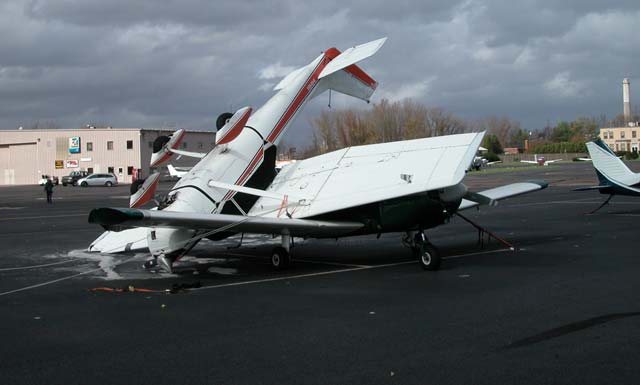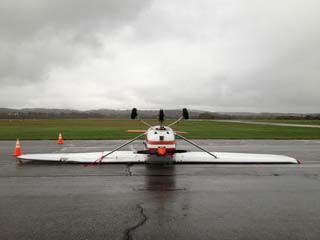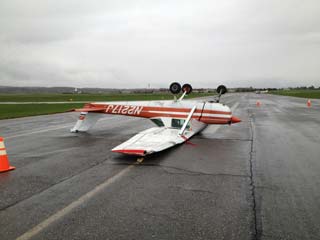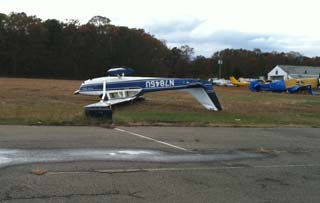East Coast airports recovering from Sandy's wrath
GA organizations join relief effort

While Hartford-Brainard Airport was well inland in Hartford, Conn., and escaped flooding that damaged many airports, powerful winds tore two aircraft from tiedowns, including the Cessna seen here. Photo courtesy Terry Keller Jr./Premier Flight Center.
New York area airports were pumped dry, but service remained limited Nov. 1 in the wake of a devastating blow from Hurricane Sandy on Oct. 29 and 30 that left millions without power, caused widespread flooding and fires, and left 93 people dead in the U.S. and Canada, according to Reuters on Nov. 2—a toll expected to climb as recovery efforts continued.
AERObridge, an organization that coordinates general aviation disaster relief, announced Nov. 1 that limited flights were to be made into into Republic Airport in Farmingdale, N.Y. to provide relief supplies, with permission from authorities. A special notice from the FAA advising aviators to steer clear of New York, particularly the area bounded by the Class B borders below 1,500 feet, remained in effect.
On Nov. 2, AERObridge President Marianne Stevenson announced flights carrying donated food, water, winter clothing, diapers, and other supplies that are urgently needed in shelters were also being accepted at Robert J. Miller Air Park in Tom's River, N.J. On Nov. 3, the effort expanded to include flights to Eagle's Nest Airport, located in West Creek, N.J., a few miles north of Atlantic City, where electric power and fuel were available, according to an email from owner Peter Weidhorn relayed to AOPA on Nov. 2
The organization noted aircraft operators who wish to join the response should contact AERObridge before planning a flight. The Fitchburg Pilots Association in Fitchburg, Mass., was organizing a donation drive, and coordinating delivery flights planned for Nov. 4 through AERObridge. Donated supplies were to be dropped off at FCA Flight Center.
 Wind gusts from the storm flipped one aircraft at AOPA’s home airport, Frederick Municipal Airport, in Frederick, Md. Photo by Kristen Seaman.
Wind gusts from the storm flipped one aircraft at AOPA’s home airport, Frederick Municipal Airport, in Frederick, Md. Photo by Kristen Seaman.
The full extent of damage was still being assessed days after the storm hit. Civil Air Patrol wings had made dozens of flights by Nov. 2 to assess storm damage and assist with search and rescue efforts, including patrols over the battered Northeast and Mid-Atlantic coasts, along with the mountains of West Virginia, where people may have been trapped by an onslaught of blizzard conditions created when Hurricane Sandy merged with a cold front. Widespread power outages hampered both communications and navigation systems. A long list of notams indicated that while many airports escaped the worst of the storm’s wrath, many navigation, lighting, and communication facilities remained offline Nov. 1.
Cape May County Airport in Cape May, N.J. was just south of the storm as it made landfall, but escaped serious damage. At 23 feet above sea level, it is the highest ground in the area, and several emergency response and other vehicles operated by local government were sheltered there, according to Bill Craft, an AOPA volunteer. Local officials also set up a pet shelter at the airport. The airport was fully operational Nov. 1, according to the airport manager.
At Igor Sikorsky Memorial Airport in Bridgeport, Conn., saltwater pushed by the storm surge flooded much of the property, and a T-hangar was blown off of its foundation. AOPA Airport Support Network volunteer David Faile said Nov. 1 that operations had apparently resumed on at least one runway, and FBO staff were hosing down the landing gear of aircraft that weathered the storm in hangars. Dozens of aircraft had been tied down outside, and it remained unclear how badly they were damaged in the flood.
“It’s definitely going to be some work,” said Faile, who is also an airframe and powerplant mechanic and leader of a local pilot organization. “If you don’t get the salt off immediately, you’re in trouble.”
Faile and other aircraft owners had been frustrated by local officials, who denied access to aircraft owners through Oct. 31 but did allow some FBO personnel on the field during that period.
 Wind gusts from the storm flipped one aircraft at AOPA’s home airport, Frederick Municipal Airport, in Frederick, Md. Photo by Kristen Seaman.
Wind gusts from the storm flipped one aircraft at AOPA’s home airport, Frederick Municipal Airport, in Frederick, Md. Photo by Kristen Seaman.
Bridgeport’s airport may have been among the hardest-hit, but was far from alone. The recovery process was hampered by widespread power outages expected to persist another week or more, in some cases.
ASN volunteer Tom Madden said Linden Airport in Linden, N.J., was still without power, along with much of the rest of the state. At least two aircraft were damaged.
Bob Dubester, who is also an ASN volunteer, said the hangars at Brookhaven Airport on Long Island appeared intact, but many aircraft sustained damage. At Teterboro Airport, ASN volunteer Steve Riethof said extensive planning and preparation by the airport management helped mitigate damage.
One of the hangars at Teterboro was made available to nearby residents fleeing a sudden flood in neighboring towns that followed the storm’s departure, when a river berm gave way, Riethof reported.
 Aircraft were damaged by wind and blowing debris at Brookhaven Airport on Long Island. Photo courtesy ASN volunteer Bob Dubester.
Aircraft were damaged by wind and blowing debris at Brookhaven Airport on Long Island. Photo courtesy ASN volunteer Bob Dubester.
The Port Authority of New York and New Jersey announced Oct. 31 that Teterboro was open for daylight operations. John F. Kennedy International Airport, La Guardia Airport, and Newark Liberty International were all open, but operating on a limited basis. Air carriers canceled more than 20,000 flights because of the storm, a tally that was also likely to rise. New York, which serves as a hub for many carriers, was slowly restoring subway and other ground transportation services on Nov. 1.
AOPA Insurance Services President Janet C. Bressler said Oct. 30 that damage claims were only beginning to arrive, and the full extent of the damage done would become clear only in the days to come. While some policies cover the cost of pre-storm relocation, many aircraft owners had little choice but to tie down tight and hope for the best.
“While none of us ever want our precious aircraft to suffer damage, some events are simply unavoidable and there will likely be quite a number of losses in Sandy’s wake,” Bressler said. “For anyone that is discovering aircraft damage resulting from Hurricane Sandy we encourage you to immediately document the damage with photos, secure the aircraft as much as possible from any further damage, and notify your insurance broker or carrier immediately to begin the claim process.”



